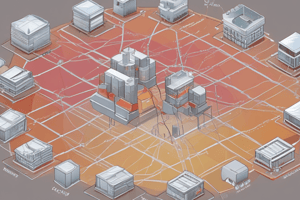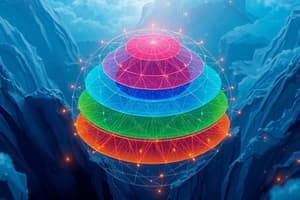Podcast
Questions and Answers
What is the primary purpose of learning the OSI model?
What is the primary purpose of learning the OSI model?
To understand the functions of network communication at different layers and aid in troubleshooting.
How does the OSI model assist in troubleshooting network issues?
How does the OSI model assist in troubleshooting network issues?
It provides a structured approach to pinpoint where problems may occur within the layers of communication.
What role does the Physical layer play in the OSI model?
What role does the Physical layer play in the OSI model?
It is responsible for the transmission of digital data bits over network communications media.
Name two technologies that operate at Layer 1 of the OSI model.
Name two technologies that operate at Layer 1 of the OSI model.
Why is the OSI model considered primarily a teaching tool today?
Why is the OSI model considered primarily a teaching tool today?
What does ARP stand for and why is it relevant in the OSI model context?
What does ARP stand for and why is it relevant in the OSI model context?
How does learning the OSI model help in communicating with technical colleagues?
How does learning the OSI model help in communicating with technical colleagues?
Describe the progression of control in the OSI model.
Describe the progression of control in the OSI model.
What does the Physical layer primarily use for data transmission?
What does the Physical layer primarily use for data transmission?
How does the Data Link layer ensure the integrity of data during transmission?
How does the Data Link layer ensure the integrity of data during transmission?
What are the two sublayers of the Data Link layer?
What are the two sublayers of the Data Link layer?
What is the primary function of the Network layer in the OSI model?
What is the primary function of the Network layer in the OSI model?
What protocol is most commonly associated with the Transport layer?
What protocol is most commonly associated with the Transport layer?
What role does the Session layer play in network communication?
What role does the Session layer play in network communication?
How does the Network layer map logical addresses to physical addresses?
How does the Network layer map logical addresses to physical addresses?
Why is the Data Link layer considered the most complex layer in the OSI model?
Why is the Data Link layer considered the most complex layer in the OSI model?
What role does the ARP protocol play in connecting to a Web server?
What role does the ARP protocol play in connecting to a Web server?
How does a computer prepare a request to be sent to the default gateway?
How does a computer prepare a request to be sent to the default gateway?
What happens at the DATA LINK layer when a web request is sent?
What happens at the DATA LINK layer when a web request is sent?
Why is the physical layer important in the context of sending web page requests?
Why is the physical layer important in the context of sending web page requests?
What is the purpose of the default gateway in the network communication process?
What is the purpose of the default gateway in the network communication process?
What is the role of the PRESENTATION layer in data processing?
What is the role of the PRESENTATION layer in data processing?
How does a web browser handle file formats it cannot display directly?
How does a web browser handle file formats it cannot display directly?
What initiates the SESSION when requesting a web page?
What initiates the SESSION when requesting a web page?
What is the function of HTML tags within a web page?
What is the function of HTML tags within a web page?
What does a web browser do when it opens a web page?
What does a web browser do when it opens a web page?
How does the TRANSPORT layer manage data from a web server?
How does the TRANSPORT layer manage data from a web server?
What is the role of Internet Protocol (IP) in data communication?
What is the role of Internet Protocol (IP) in data communication?
How does a computer determine if a web server is local or remote?
How does a computer determine if a web server is local or remote?
What is the primary function of the Presentation layer in the OSI model?
What is the primary function of the Presentation layer in the OSI model?
How does the Application layer interact with user data?
How does the Application layer interact with user data?
In what way does a Web browser function as an Application layer component?
In what way does a Web browser function as an Application layer component?
What role does the Presentation layer play in supporting the Application layer?
What role does the Presentation layer play in supporting the Application layer?
Can you explain the data flow between the Presentation and Application layers?
Can you explain the data flow between the Presentation and Application layers?
Give an example of a protocol that operates at the Application layer.
Give an example of a protocol that operates at the Application layer.
What activities are associated with the Application layer in a local area network scenario?
What activities are associated with the Application layer in a local area network scenario?
What is the significance of handling various file formats in the Web browser application?
What is the significance of handling various file formats in the Web browser application?
Flashcards
OSI Model Purpose
OSI Model Purpose
A networking framework organizing communication protocols into layers, used primarily for education and understanding network functionality.
OSI Model Layers
OSI Model Layers
The OSI model conceptually divides network architecture into seven distinct layers, with lower layers handling physical signals and higher layers focusing on user-level network protocols.
Physical Layer
Physical Layer
The lowest layer of OSI model responsible for transmitting data bits between devices over physical media, such as cables.
OSI Model Benefits
OSI Model Benefits
Signup and view all the flashcards
Layer 1 of OSI
Layer 1 of OSI
Signup and view all the flashcards
Network Architecture
Network Architecture
Signup and view all the flashcards
Network Protocols
Network Protocols
Signup and view all the flashcards
Troubleshooting
Troubleshooting
Signup and view all the flashcards
Physical Layer
Physical Layer
Signup and view all the flashcards
Data Link Layer
Data Link Layer
Signup and view all the flashcards
Network Layer
Network Layer
Signup and view all the flashcards
Transport Layer
Transport Layer
Signup and view all the flashcards
Session Layer
Session Layer
Signup and view all the flashcards
MAC Address
MAC Address
Signup and view all the flashcards
IP Address
IP Address
Signup and view all the flashcards
OSI Model Layer
OSI Model Layer
Signup and view all the flashcards
IP Protocol
IP Protocol
Signup and view all the flashcards
ARP
ARP
Signup and view all the flashcards
Default Gateway
Default Gateway
Signup and view all the flashcards
MAC Address
MAC Address
Signup and view all the flashcards
Data Link Layer
Data Link Layer
Signup and view all the flashcards
Presentation Layer Function
Presentation Layer Function
Signup and view all the flashcards
Application Layer Role
Application Layer Role
Signup and view all the flashcards
OSI Model Layer 6
OSI Model Layer 6
Signup and view all the flashcards
Web Browser as Application
Web Browser as Application
Signup and view all the flashcards
Web Page Display
Web Page Display
Signup and view all the flashcards
Application Layer Protocol Example
Application Layer Protocol Example
Signup and view all the flashcards
Web Server Interaction
Web Server Interaction
Signup and view all the flashcards
OSI Layer 7
OSI Layer 7
Signup and view all the flashcards
Presentation Layer
Presentation Layer
Signup and view all the flashcards
Web Browser
Web Browser
Signup and view all the flashcards
HTTP
HTTP
Signup and view all the flashcards
Session
Session
Signup and view all the flashcards
TCP
TCP
Signup and view all the flashcards
Transport Layer
Transport Layer
Signup and view all the flashcards
Network Layer (IP)
Network Layer (IP)
Signup and view all the flashcards
Web Server
Web Server
Signup and view all the flashcards
Study Notes
Why Should We Learn the OSI Model?
- Learning the OSI model helps understand functions, timing, and how web browsers, internet protocols, and MAC addresses work.
- It facilitates troubleshooting computer problems and communication with technical personnel.
- The OSI model simplifies learning and troubleshooting, crucial for computer problem-solving.
OSI Model (Layers)
- The OSI model is a networking framework, shown in a diagram as 7 layers, used to implement network protocols.
- Layers are structured to pass control in a logical sequence starting from the bottom layer (physical).
- The bottom layers (physical and data link) deal with signals, data chunks, and network routing.
- Top layers handle user requests, data representation, and network protocols.
- OSI model is a foundation for network architecture design.
- The OSI model helps in understanding various network functions: (application, presentation, session, transport, network, data link, and physical).
- Each layer has a specific purpose in communicating over a network.
Physical Layer
- The physical layer transmits digital data bits over the network.
- It uses signaling supported by media, e.g., electric signals, radio waves, infrared.
- Key functions involve physical connection, physical addressing, cable connectors, and hubs.
Data Link Layer
- The data link layer is responsible for checking physical errors during transmission: converting data bits into frames, determining access control schemes (MAC addresses), managing network device access to the physical medium.
- The data link layer is critical because it manages the complexity of physical medium access.
- The layer is divided into Media Access Control (MAC) sub-layer and Logical Link Control (LLC) sub-layer.
Network Layer
- The network layer handles routing and the concept of logical addresses (like IP addresses) for devices on the network.
- This layer formats data into packets for transfer to the transport layer and manages logical addressing.
- It maps logical addresses to physical addresses (using ARP).
Transport Layer
- The transport layer delivers data across network connections.
- The most common protocol in this layer is TCP.
- Other important functions include error recovery, flow control, and support for retransmission (reliability).
Session Layer
- Manages the sequence and flow of events that initiate and tear down network connections, supporting multiple types of network connections.
Presentation Layer
- The presentation layer deals with data syntax format conversions.
- Encrypts/Decrypts data as required for handling various message formats (e.g., images, audio).
Application Layer
- Delivers networking services to end-user applications, such as web browsers.
- Provides data management to/from the presentation layer.
- Includes protocols like HTTP for web browser applications.
Studying That Suits You
Use AI to generate personalized quizzes and flashcards to suit your learning preferences.
Related Documents
Description
Dive into the OSI model, a crucial framework for networking. This quiz explores its 7 layers, how they function, and their importance in troubleshooting and network design. Learn how each layer contributes to effective communication and problem-solving in computer networks.




